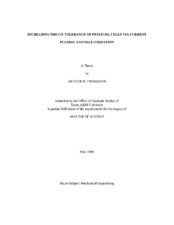| dc.description.abstract | An investigation was conducted to determine and compare the effect of cell current pulsing and "self-oxidation" in increasing the CO tolerance of a PEM fuel cell. The most effective pulsing parameter values were also determined. Current pulsing involves periodically demanding positive current pulses from the fuel cell to create an anode over-potential, while "self-oxidation" or sustained potential oscillations is achieved when the anode catalyst becomes so saturated with CO that the anode over-potential increases to a value at which CO is oxidized from the catalyst surface. The CO tolerance of a fuel cell system with a Pt-Ru anode was tested using 50 and 496 ppm CO in the anode fuel. The performance of the system declined with an increase in CO concentration. Current pulses of various amplitude, frequency, and duty cycle were applied to the cell while CO was present in the anode fuel. With 50 ppm CO in the anode fuel, the most effective pulse in increasing CO tolerance while maintaining normal cell operation was 1.0 A/cm2, 0.25 Hz, and a 5% duty cycle. A pulse (120 Hz, 50% duty cycle) similar to the ripple current often generated when converting DC to single-phase 60 Hz AC had a positive effect on the CO tolerance of the system, but at frequencies that high, the pulse duration was not long enough to completely oxidize the CO from the catalyst surface. With 496 ppm CO in the anode fuel, a pulse of 1.0 A/cm2, 0.5 Hz, and a 20% duty cycle proved most effective.
When the cell was exposed to 496 ppm CO, without employing pulsing, "self-oxidation" occurred and CO was periodically oxidized from the catalyst surface. However, pulsing allowed the cell to operate at the desired voltage and power a higher percentage of the time than "self-oxidation"; hence, pulsing was more effective. | en |


